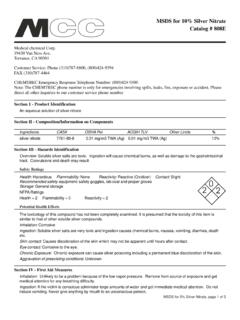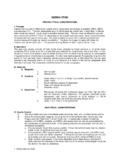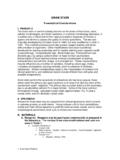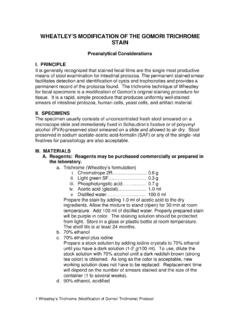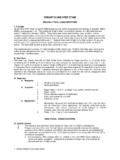Transcription of DETERMINATION OF PAR ASITEMIA - Med-Chem
1 1 Garcia ( DETERMINATION of parasitemia Protocol) DETERMINATION OF parasitemia PREANALYTICAL CONSIDERATIONS I. Principle It is important to report the level of parasitemia when blood films are examined and found to be positive for malaria parasites. Because of the potential for drug resistance in some of the Plasmodium species, particularly P. falciparum, it is important that every positive smear be assessed and the parasitemia reported exactly the same way on follow-up specimens as on the initial specimen (1-6). This allows the parasitemia to be followed after therapy has been initiated. In cases where the patient is hospitalized, monitoring should be performed at 24, 48, and 72 h after initiating therapy.
2 Generally the parasitemia will drop very quickly within the first 2 h; however in cases of drug resistance, the level may not decrease, but actually increase over time. II. Specimen The specimen consists of stained thick or thin blood films that have been examined a minimum of 300 oil immersion fields per blood film to determine film is positive for malaria parasites. III. Materials A. Reagents None B. Supplies None C. Equipment 1. Microscope, binocular with mechanical stage; low (10x), high dry (40x), and oil immersion (100x) objectives; 10x oculars; calibrated ocular micrometer; light source equivalent to a 20-W halogen or 100-W tungsten bulb; blue and white ground-glass diffuser filters.
3 ANALYTICAL CONSIDERATIONS IV. Quality Control A. Prepare and stain films from normal blood, and microscopically evaluate the staining reactions of RBCs, platelets and WBCs (normally done during staining procedure using Giemsa or Wright s stains). B. The microscope should be calibrated, and the objectives and oculars used for the calibration procedure should be used for all measurements on the microscope. Post the calibration factors for all objectives on the microscope for easy access (multiplication factors can be pasted right on the body of the microscope) (see procedures and ). Although there is not universal agreement, the microscope should probably be recalibrated once each year.
4 This recommendation should be considered with heavy use or if the microscope has been bumped or moved multiple times. If the microscope does not receive heavy use, then recalibration is not required on a yearly basis. V. Procedure A. Thin blood film: counting several hundred to 1,000 RBCs, report the percentage of infected RBCs per 100 RBCs counted ( , , etc.) B. Thick or thin blood film: counting one hundred WBCs (or more), report the number of parasites per 100 WBCs on the smear. 1. This figure can be converted to the number of parasites per l of blood; divide the number of parasites per 100 WBCs by 100, and multiply that figure by the number of WBCs per l of blood.
5 2. Depending on the parasitemia , 200 or more WBCs may have to be counted, so the denominator may vary (it may be 200 or even more). 3. Using this method, blood for both the peripheral smears and cell counts must be collected at the same time. 2 Garcia ( DETERMINATION of parasitemia Protocol) POSTANALYTICAL CONSIDERATIONS VI. Reporting Results (Table 1) A. Using the thin blood film method, report the percentage of parasite-infected RBCs per 100 RBCs counted. Example: Plasmodium falciparum, parasitemia = B. Using the thick/thin blood film method, report the number of parasites per l of blood. C. Example: Plasmodium falciparum, parasitemia = 10,000 per l of blood VII.
6 Procedure Notes A. It is critical that the same reporting method be used consistently for every subsequent set of blood films so that the parasitemia can be tracked for decrease or possible increase, indicating resistance. B. Remember, drug resistance may not become evident for several days; the parasitemia may even appear to be dropping before it begins to increase again. C. It is very important that any patient with P. falciparum infection be monitored; drug resistance has also been reported in P. vivax infections. D. It is critical to remember that mixed malarial infections occur, many of which will include P.
7 Falciparum. VIII. Limitations of the Procedure A. A light infection may be missed in a thin film, whereas the increased volume of blood present on a thick film may allow the detection of the infection, even with a low parasitemia . B. If the smears are prepared from anticoagulated blood that is more than 1h old, the morphology of both parasites and infected RBCs may not be typical. C. It is important that good quality blood films be examined and counted according to directions; poorly prepared and/or stained blood films will lead to incorrect assessments of the parasitemia (both too low and too high). D. Follow-up counts are critical in following the patient, and it is critical to understand the types of malaria resistance (see Table 2).
8 TABLE 1 parasitemia determined from conventional light microscopy: Clinical correlationa parasitemia Parasites/ l Clinical Correlation 5-20 Number of organisms that are required for a positive thick film (sensitivity) NOTE (TBF): Examination of 100 TBF fields ( l) may miss infections up to 20% (sensitivity of 80-90%); at least 300 TBF fields should be examined before reporting a negative result. NOTE (THBF): Examination of 100 THBF fields ( l); at least 300 THBF should be examined before reporting a negative result; BOTH TBF and THBF should be examined for every specimen submitted for a suspect malaria case.
9 ONE SET (TBF + THBF) OF NEGATIVE BLOOD FILMS DOES NOT RULE OUT A MALARIA INFECTION. 100 Patients may be symptomatic below this level 10,000 Level above which immune patients will exhibit symptoms 2% 100,000 Maximum parasitemia of P. vivax and P. ovale (infect young RBCs only) 2-5% 100,000-250,000 Hyperparasitemia, severe malariab, increased 3 Garcia ( DETERMINATION of parasitemia Protocol) mortality 10% 500,000 Exchange transfusion may be considered, high mortality a Adapted from references 2, 6. b WHO criteria for severe malaria are parasitemia >10,000/ l and severe anemia (hemoglobin <5g/l). Prognosis is poor if >20% of parasites are pigment containing trophozoites and schizonts and/or if >5% of neutrophils contain visible pigment.
10 TBF = thick blood film; THBF = thin blood film Table 2. Malaria Resistance Resistance Definition Comments Sensitive From initiation of therapy, asexual parasites are cleared by day 6; no evidence of recrudescence up to day 28 ? Peripheral blood films appear to go from positive to negative very quickly (can be a change from one draw to the second draw 6 h later). Resistance type I (RI) From initiation of therapy, asexual parasites have cleared for at least two consecutive days (the latest day being day 6); recrudescence follows ? Parasite count initially drops and blood films appear to be negative; patient should be monitored for a period of days, particularly if drug-resistant P.
